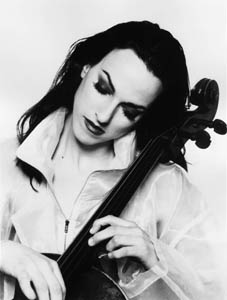![[Metroactive Music]](/gifs/music468.gif)
[ Music Index | Santa Cruz | Metroactive Home | Archives ]
Crossed Wires
Technique and technology don't mix at Maya Beiser performance
By Scott MacClelland
Cellist Maya Beiser, who performed Sunday, Jan. 11, at UC-Santa Cruz, enjoys an enviable position in the world of new classical music: too few such specialists; too much new music. Yo Yo Ma, also to be counted a new music aficionado, has plenty on his plate. Most other prominent cellists seem content with rehashing the standard and familiar repertory.
Whether Beiser, an erstwhile member of New York's avant-garde Bang on a Can All Stars, can survive as a solo artist is not certain. But she certainly has attracted some of the best and brightest composing talent currently available. Her short program, titled after its longest piece, David Lang's World to Come, contained an important commissioned work by Steve Reich and a heartfelt, even inspired, piece by Osvaldo Golijov, the Argentinian composer whose St. Mark Passion of 2000 has attracted international success and acclaim. Arvo Pärt's "greatest hit," Fratres, opened the program, and an imaginative work by Louis Andriessen opened the second half.
On the evidence of Sunday evening, Beiser, who grew up on an Israeli kibbutz and studied with Aldo Parisot, Alexander Schneider and Isaac Stern, is neither a brilliant performer nor a compelling artistic personality. These apparent limitations she skillfully masked behind amplification, electronically enhanced reverberation, multiple layers of herself previously recorded, and fast-moving visual images projected large on the wall behind her. In most cases, her actual, live playing was, in terms of cello technique, pretty simple, and not flawless.
The Pärt, whose arranged versions for all manner of instrumentation are now running a close second to the much-molested Pictures at an Exhibition, opened with Beiser playing harmonics live over prerecorded tracks that were notably more room-filling through the hall's sound system. (Harmonics, achieved by lightly touching the strings at crucial "nodes," are tough to control anyway, and this was no exception.)
Andriessen's La Voce, based on a poem by Cesare Pavese (and played before a static projection of an empty room), called for Beiser to recite the Italian verses and vocalize as she variously stroked and hammered her instrument. At times the score called for her to silently bow the air above the strings. In the 25-minute Lang, the impression was one of tape loops being created onstage, then played back as Beiser added a new voice in counterpoint. The original material consisted of a rising arpeggio ostinato, plus much obsessing on single tones. Moreover, Beiser seemed confused as to when to join the recorded material, trying to jump in two or three times before she actually put bow to string. The work gave little to engage the intellect, but rather depended heavily on its amplified, atmospheric sonorities. Strange choice for the above reasons, but evidently popular with foundations; no fewer than seven institutions, including UC-Santa Cruz, contributed funds to the commission.
[ Santa Cruz | Metroactive Central | Archives ]
Copyright © Metro Publishing Inc. Maintained by Boulevards New Media.
For more information about Santa Cruz, visit santacruz.com.
![]()

Pity Pity Bang Bang: Former Bang on a Can All Star Maya Beiser didn't live up to expectations in her solo show.
From the January 14-21, 2004 issue of Metro Santa Cruz.